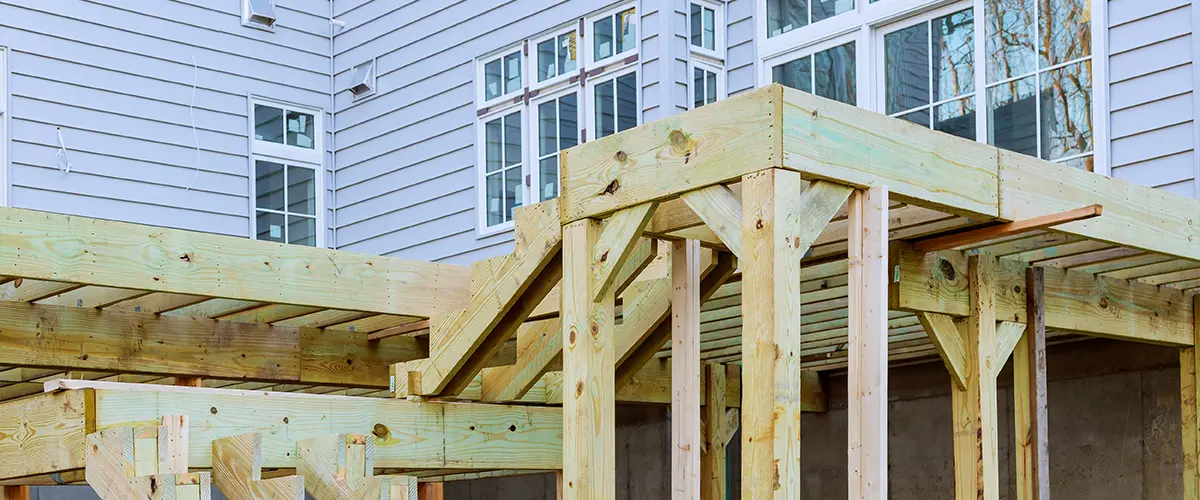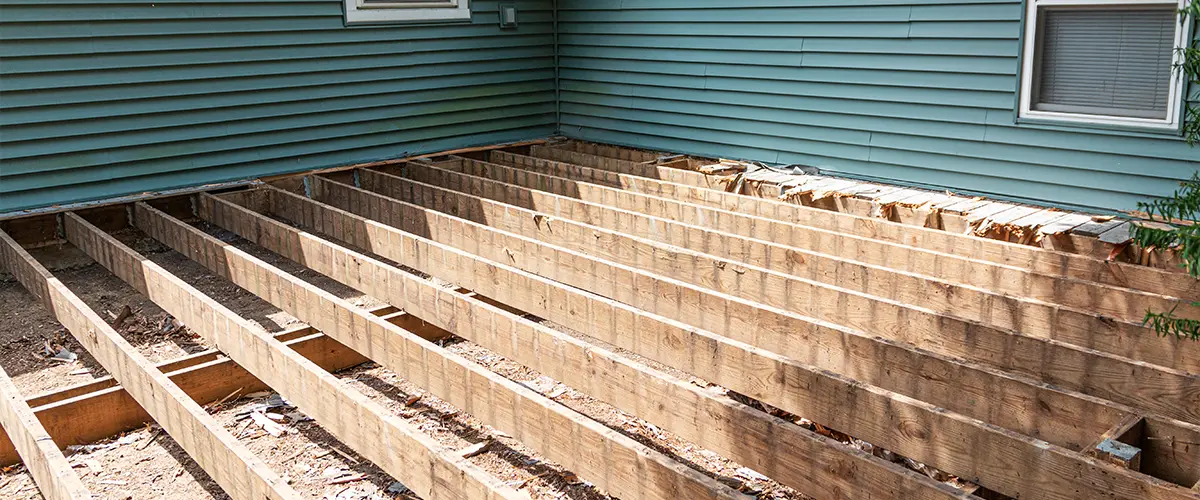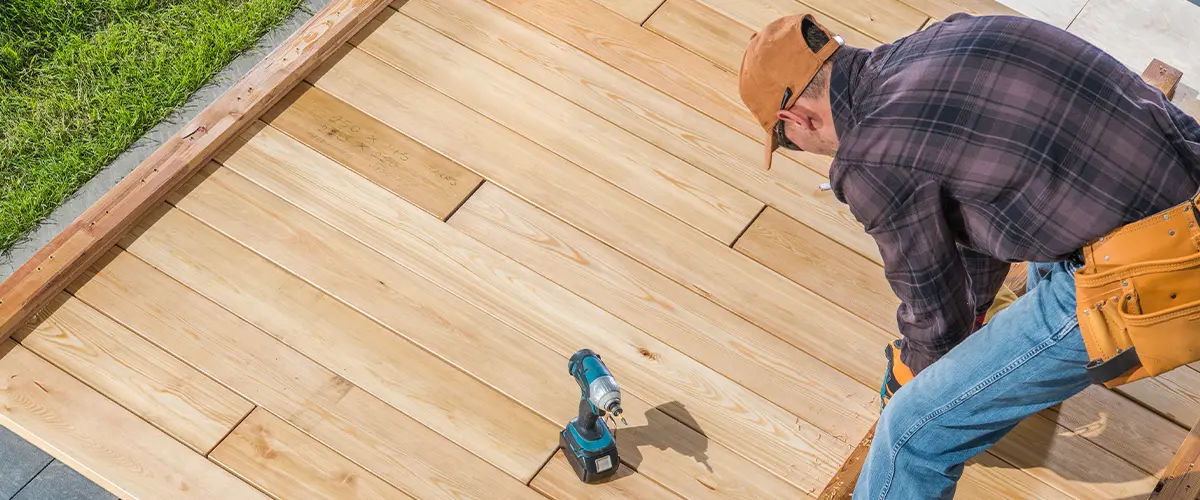Attaching decking to house the proper way is imperative to having a safe deck. It means you can host the best family gatherings without putting anyone’s life at risk, and it also means a lot less trouble during the building phase.
Because all decks attached to a house require a building permit, the building inspectors from your city building department will undoubtedly check the method used to attach the deck.
If all is good, the deck building process can go on. If not, most of the time they’ll ask you to demolish everything and start from the beginning.
But let’s see how professionals attach decking to a house, so you know what to expect.

Attaching Decking To House
- The first is that the deck must be properly anchored to the house. This is done by using metal brackets that are attached to the framing of the house and the house wall. The brackets are then connected to the deck posts with bolts.
- Another important consideration is the use of flashing. Metal flashing is a piece of metal that is placed over the ledger board to prevent water from seeping behind the ledger and into the house. It's secured with structural screws made to support heavy weights.
In some cases, the building inspector will require that the gaps between the deck boards be filled with caulk or another sealant to further prevent water damage. Your contractor will know how to deal with the phase of the deck construction.
It takes a lot of knowledge and experience to make sure the deck joists are strong and durable, the house’s rim joist is secured, the exterior sheathing remains intact, and the entire length of the deck is secured.
What Comes After The Flashing?
Once the ledger board is properly secured and the flashing is in place, your deck is attached to the house and you can start installing the boards.
If you’re using pressure-treated lumber, it’s important to wait at least two weeks before staining or sealing the wood. This will give the lumber time to dry out and prevent the chemicals in the wood from leaching into the soil.
When it comes to attaching decking boards, there are a few different options. The most common is to use nails or screws that are driven through the board and into the joists.
Another option is to use hidden fasteners, which are small metal clips that fit between the decking boards and attach them to the joists.
Whichever method you choose, make sure that the fasteners are driven into the joists at an angle so that they grip the wood securely. Also, be sure to leave enough space between the boards so that water can drain properly.
Once the decking is installed, you can add finishing touches like railings and stairs.

Things Needed for attaching decking to a house
Tools Required
- Caulk gun
- Circular saw
- Cordless drill
- Drill bit set
- Hammer
- Level
- Miter saw
- Socket/ratchet set
Materials Required
- Acrylic caulk
- Drip cap
- Galvanized flashing
- Galvanized joist hangers
- Galvanized lag screws
- Galvanized nails and screws
- Pressure-treated wood
- Z-flashing

Is The Fascia The Same As The Ledger Board?
In short, no.
- The ledger board is what connects the wood deck to the side of your home. It's all about safety and making your deck construction safe for you and your loved ones. Which is why you need a building permit for it. Attaching decking to a house wouldn't be possible without a ledger board.
- The fascia, on the other hand, is the side of your deck that remains visible. It's all about aesthetics and making your deck look beautiful and complete. Without a fascia, the edge of the decking boards will remain visible, ruining the look of your deck.
Why Do You Need Building Permits
Building permits are mandatory for attaching decking to a house or for all elevated decks. The only decks that don’t require a permit are ground-level, freestanding decks.
A building permit is the paperwork you’ll need to start building your deck in accordance to the building requirements in your area. To obtain it, you’ll have to apply for it with your local building department.
You’ll have to submit drafting plans, blueprints, materials, designs, and everything else that will impact your deck construction.
Why Working With A Professional Makes Your Project Go Smoother
Professional deck builders are licensed contractors and they’ll be able to obtain the building permit much faster. They’re accustomed to the process and they know the ins and outs of the industry.
Besides, you won’t have to deal with all the paperwork and going back and forth with the right documents to get the permit.
The building permit fee is usually included in the final quote, and you’ll be able to see it on your contract.
Here at Werner Decks, we take care of everything from start to finish. You won’t have to deal with any paperwork or the hassle of getting the permit. We’ll schedule the inspections and we’ll make sure your deck is up to the highest standards.

Conclusion
Attaching decking to a house is a difficult task that requires a professional to make sure everything is safe and installed properly. If you’re thinking about DIY-ing this task, all we can do is arm you with the minimum knowledge, but we can’t give you our experience.
If you don’t want to risk it and you want your deck construction to be 100% safe and functional, having your local deck builders build your project is the best choice you can make.
At Werner Decks, we offer professional deck building and deck repair in Annapolis, Severna Park, Arnold, Crofton, Edgewater, and neighboring counties. We’re a deck building company dedicated to building safe and beautiful decks that can entertain your guests and help you kick back with your friends.
Call us today at (443) 926-6996 to get started on your deck building project, or request a free quote and we’ll get back to you as soon as possible!
